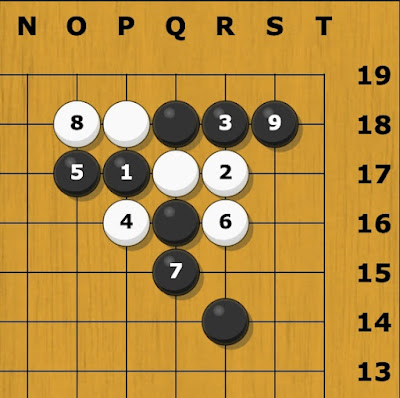Before I show my Essential Go Activities chart for the week I would like to talk about my recent homework from Ben Mantle. Ben decided that some joseki study would be a good addition at this point in my go development.
The diagram above is from AI Sensei. It is from the game that Ben and I reviewed in my lesson from September 1st. In that game I had stepped back when my opponent played the q17 wedge. Ben told me that I should have given atari from the outside, and AI clearly agrees. Ben spent about 15 minutes of our 90 minute lesson explaining how this joseki can go.
Ben suggested that I memorize this and use it in my games. Not only should I give atari at A when I am black, but I should also try wedging at q17 as white.
I definitely saw the value of learning this joseki, but I was skeptical of my ability to memorize it simply by rewatching the video a number of times. I decided to invest a good deal of time creating a demo file to study.
Rather than using the sgf of the review on OGS as a starting point I decided to create the demo file from scratch in SmartGo One on my iPad while watching the video of my lesson. The fact that OGS numbers the moves of a variation was quite helpful in this process. I needed to watch a few seconds at a time and add the variations in the demo file while meticulously typing in Ben's comments. This process helped to cement the variation in my mind.
The aim was to be able to review the sgf file at my own pace and read the comments so I would be able to understand the reasons behind the moves. I am not proud that it took me about three hours to create this demo file. However, I am pleased that after doing so it only took me between 30 minutes to an hour to be able to master replaying the main line of this joseki. Below is the main line of the joseki without the forcing moves white gets to play at the end starting at n17.
There are some other gems I need to memorize from some of my other lessons with Ben, and I think that I can probably do better creating the demo files in the future now that I have made one successfully.
I even played out the joseki on a real board.
Above I have played the joseki out with one of white's forcing move continuations. This can actually be played out with the black shimari facing in the opposite direction and also with switching the colors. So it can be played out 16 different way.
I'm looking forward to doing more joseki study.
Now for my Essential Go Activities chart:










No comments:
Post a Comment